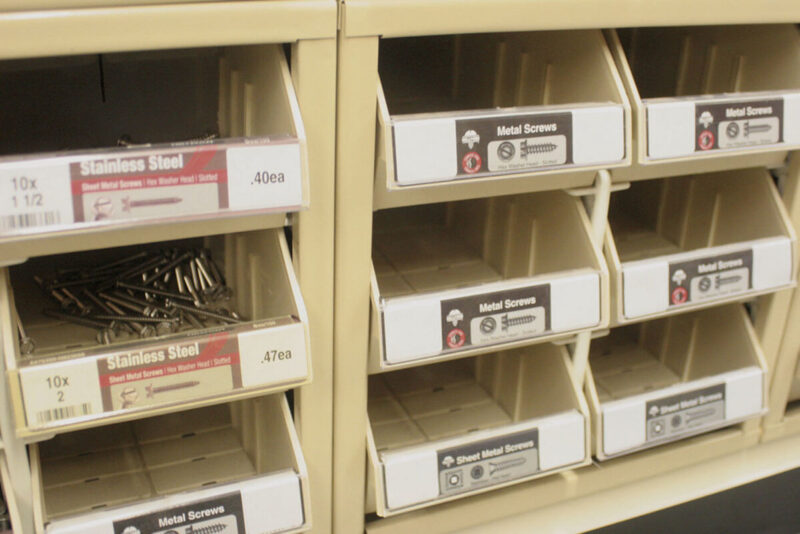Kelly Kenoyer
Spots on store shelves remain empty of stock across Sweet Home, as gaps in inventory have narrowed after eight months of COVID-19 pandemic.
While specific stores in town are seeing runs on their products, the problem isn’t just local: it’s state and nationwide, said Oregon Business and Industries CEO Sandra McDonough.
“There’s the disruption in global markets. There is what happens when people stay at home and they can’t go anywhere so they look for projects. And then, you know, the tragedy of the fires, which is just going to have to create a whole ‘nother issue for some supplies.”
The pandemic hit global markets really hard, she said. “People were out of work so production was down; in some places shipping was down, it was just harder to move product.”
And those global supply chains have a local impact, seen on bare store shelves and bizarre limitations on what products are available. Toilet paper was a memorable problem in March, but limitations have been “episodic” and shifting since then, McDonough said.
The local Thriftway supermarket has seen runs on random groceries and some vendors are limiting flavor options, said Manager Chad McDonald.
“It’s still hit and miss,” he said. A supplier told him recently that they are completely out of canned pumpkin, for instance.
“They bought all the stores out, then the suppliers ran out, so they had to wait for the pumpkins to grow out in the fields, and that stuff is just becoming available to us again,” he said.
Soda brands and chip brands are still sending inventory to stores, but in much more limited flavor ranges.
“Pepsi is a great example, for 12-packs they’re only making the top eight or nine flavors,” McDonald said.
McDonough said those changes in product availability don’t surprise her.
“If you think about the pressures that the manufacturers are dealing with, you’ve got limited workers.
“Virtually every manufacturer has had to change how they do things, had to change their processes. And so that has meant, I think, for some that they just can’t push as much out the door.”
Manufacturers have had to limit the staffing in factories to meet social distancing requirements, along with adding personal protective equipment.
That’s on top of shifts in demand, such as an increase in demand for dairy products like cheese and ice cream, while restaurants being closed has shuttered the market on fine dining ingredients, like seafood.
Even as suppliers struggle to meet demand in grocery stores, they’ve lost a lot of profits because of the restaurant closures, McDonough said.
“In most years, 50 percent of their sales are at the grocery stores and 50% of their sales are to restaurants. They lost 50 percent, because you can’t make up all of those sales at grocery stores.”
Made in China
Grocery stores aren’t the only stores hit. Hoy’s Hardware has seen a lot of interest from customers pursuing home projects during the pandemic, but keeping supplies on the shelves is an uphill battle, owner Greg Mahler said.
He said the store ran out of gardening supplies in spring, then canning supplies in summer, then sprinklers and hoses during the fires.
“It’s been a rollercoaster,” he said. “Plastic stuff, like containers, is hard to come by because a lot of it comes from China.”
He ran into similar supply chain issues even with American companies “because they use parts that come from China.”
The inventory problems are a bit of a wake-up call for the U.S.’s overreliance on foreign trade, he suggested.
“It’s a pull-your-hair-out situation this whole year,” Mahler said.
Hoy’s still has bare shelves where canning supplies typically are kept, and Mahler said he’s not sure when he’ll be able to resupply.
“A lot of that stuff comes from China as well,” he added.
Threadbare Shelves
In downtown Sweet Home, the Seamingly Creative fabric store hasn’t dodged the inventory woes either.
“My wholesalers don’t have stock for me to get,” said owner Lerena Ruby. In an order of 347 types of items, she could only get 124 from her suppliers.
“I’m completely out of white thread,” she said. “The staples are what I have trouble getting.”
A lot of fabric is made in the U.S. and printed in Mexico, and those options are still pretty available. But it’s hard for customers to work on projects if they can’t get access to the basics.
“It’s sad because the government sent out these checks so people could shop, but we don’t have anything,” Ruby said.
She was able to make ends meet at the beginning of the pandemic by stitching her own masks and selling them for $3 each. She’s made over 4,000 masks since, with the help of her husband Howard, who turns the masks inside out after she stitches them.
“We watch movies together while I pin them,” she said.
Wildfires Contribute
On top of challenges in the market driven by the pandemic, the wildfires created runs on other kinds of products, like the hoses that are sold out at Hoy’s. But the poor air quality led to other runs that are hyper-local.
O’Reilly Auto Parts had a run on air filters and still hasn’t been able to restock, said staffer Jared Claunch.
“We’re still waiting for suppliers to catch up,” he said.
Even big box stores like Lowe’s and Home Depot saw runs on box fans and filters as residents fought to maintain good air quality inside their homes. Hoy’s ran out of those too, Mahler said.
Even as the markets struggle to get balanced after numerous disasters this year, McDonough said the way forward is to find a way to control “and ultimately live with the virus.”
“The bottom line is consumer confidence: When are people like you and I going to feel comfortable going out again spending money again, going into crowded stores going to restaurants?” she said.
“We probably won’t bottom out for a couple of years, to really see the absolute bottom of the recession.”





